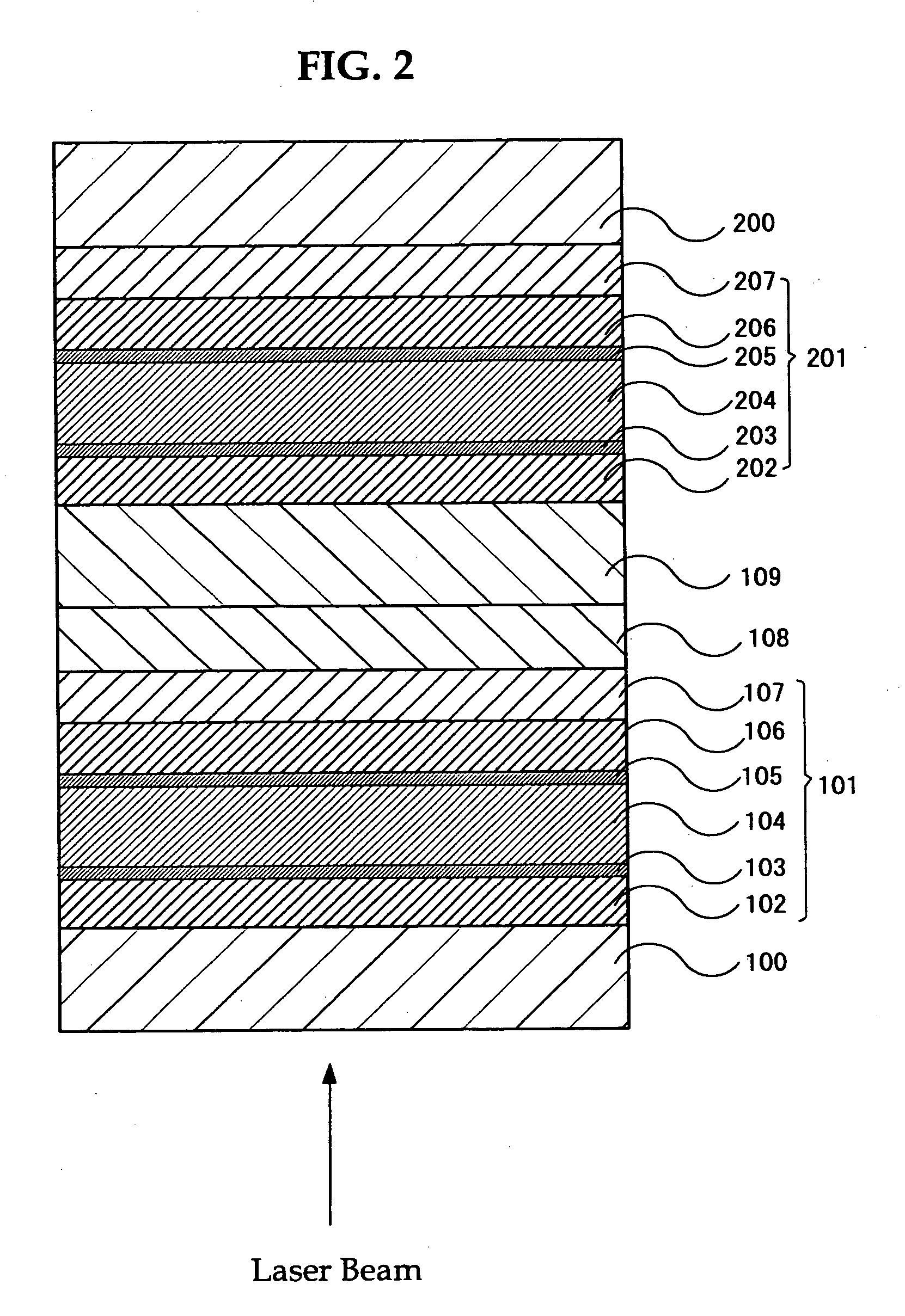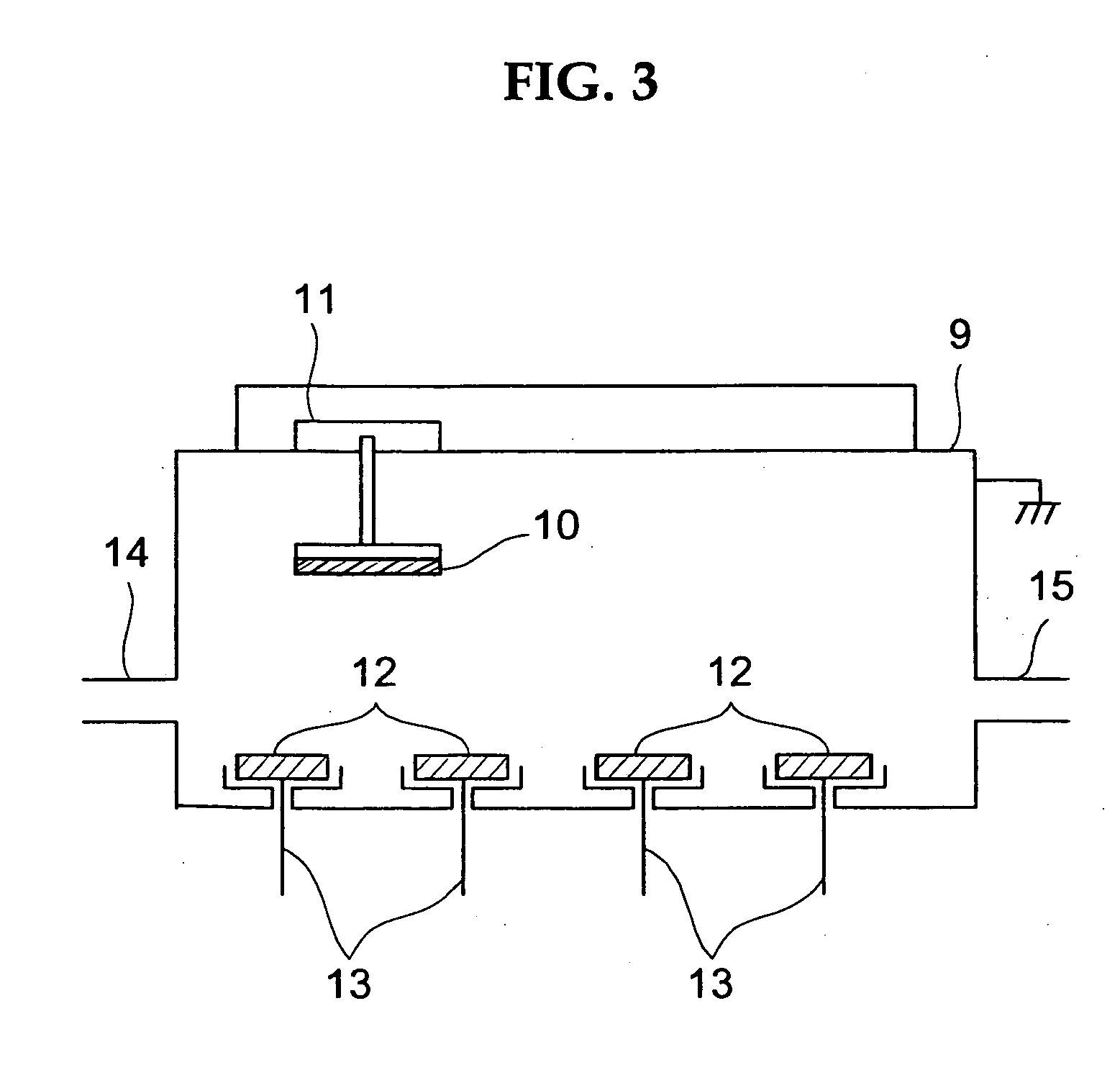Optical recording medium and optical recording process using the same
a technology of optical recording medium and optical recording process, which is applied in the field of optical recording medium, can solve the problems of overwriting distortion, noise at reproducing signals, and disadvantages of having a large value of ac/aa, and achieve the effects of improving the repetitive recording properties of light-transmittance optical recording medium, double the recording capacity, and improving the repetitive recording properties
- Summary
- Abstract
- Description
- Claims
- Application Information
AI Technical Summary
Benefits of technology
Problems solved by technology
Method used
Image
Examples
example 1
[0086] Laser wavelength: 402 nm
[0087] Spotting diameter: 0.3 μm (1 / e2)
[0088] Recording power / erasing power: [0089] the first recording layer structure (7 mW / 3 mW) [0090] the second recording layer structure (8.5 mW / 3.5 mW)
[0091] Reproducing power: 0.6 mW
[0092] Modulation code: 1 to 7 modulation
[0093] Recording linear velocity: 16.5 m / s
[0094] Reproducing linear velocity: 5.7 m / s
[0095] Recording strategy:
[0096] (n-1) types of multi-pulses (in a case of 3 T, the multi-pulse is two), where “T” is an inverse number of a frequency of a standard clock [0097] Head pulse width: 0.4 T [0098] Multi-pulse width: 0.4 T [0099] Off pulse width: 0.4 T
example 2
[0100] Laser wavelength: 410 nm
[0101] Spotting diameter: 0.52 μm (1 / e2)
[0102] Recording power / erasing power: [0103] the first recording layer structure (7.5 mW / 3.5 mW) [0104] the second recording layer structure (9.5 mW / 3.9 mW)
[0105] Reproducing power: 0.55 mW
[0106] Modulation code: 1 to 7 modulation
[0107] Recording linear velocity: 16.5 m / s
[0108] Reproducing linear velocity: 5.7 m / s
[0109] Recording strategy: [0110] (n-1) types of multi-pulses (in a case of 3 T, the multi-pulse is two), where “T” is an inverse number of a frequency of a standard clock [0111] Head pulse width: 0.4 T [0112] Multi-pulse width: 0.4 T [0113] Off pulse width: 0.4 T
[0114] The results of the evaluation are shown below. Table 1 shows the results of Example 1 and Table 2 shows the results of Example 2. Here, in a recording property, “⊚,”“◯” and “×” are given in the tables based on an evaluation whether or not a sample may be used in practice. In an evaluation in a first recording layer, “⊚” shows that...
example 3
[0118] Laser wavelength: 402 nm
[0119] Spotting diameter: 0.3 μm (1 / e2)
[0120] Recording power / erasing power: [0121] the first recording layer structure (7 mW / 3 mW) [0122] the second recording layer structure (9 mW / 3.3 mW)
[0123] Reproducing power: 0.6 mW
[0124] Modulation code: 1 to 7 modulation
[0125] Recording linear velocity: 16.5 m / s
[0126] Reproducing linear velocity: 5.7 m / s
[0127] Recording strategy: [0128] (n-1) types of multi-pulses (in a case of 3 T, the multi-pulse is two), where “T” is an inverse number of a frequency of a standard clock [0129] Head pulse width: 0.4 T [0130] Multi-pulse width: 0.4 T [0131] OFF pulse width: 0.4 T
PUM
| Property | Measurement | Unit |
|---|---|---|
| diameter | aaaaa | aaaaa |
| diameter | aaaaa | aaaaa |
| depth | aaaaa | aaaaa |
Abstract
Description
Claims
Application Information
 Login to View More
Login to View More - R&D Engineer
- R&D Manager
- IP Professional
- Industry Leading Data Capabilities
- Powerful AI technology
- Patent DNA Extraction
Browse by: Latest US Patents, China's latest patents, Technical Efficacy Thesaurus, Application Domain, Technology Topic, Popular Technical Reports.
© 2024 PatSnap. All rights reserved.Legal|Privacy policy|Modern Slavery Act Transparency Statement|Sitemap|About US| Contact US: help@patsnap.com










